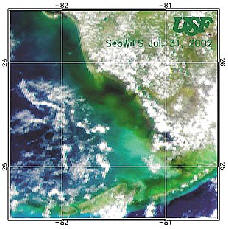|
A new area of black water has formed off Sanibel Island
Naples Daily News
11th August 2002
By CATHY ZOLLO, crzollo@naplesnews.com
and JEREMY COX, jgcox@naplesnews.com
More than half of the coral in western Florida Bay, north of the Florida Keys was destroyed in the past 12 months, and researchers who've been monitoring Keys coral since 1996 say the black water event from last spring is to blame.
"I'm sure that's what caused it," said James Porter, a leading coral expert who heads the research team. "It's something to do with the water chemistry, but it's beyond anything we know about."
Porter said his team of researchers measured a 60 percent loss of over one year, "which is the highest rate of loss we have ever seen anywhere in the Florida Keys in a single year," he said. "Even Hurricane Georges did not do this kind of damage."
Five coral species were completely wiped out in areas Porter monitors in the bay, a an area of patch reefs north of the lower third of the island chain. He noted the demise of centuries-old boulder corals, and large numbers of other bottom dwellers such as sea squirts, sea biscuits and sponges.
Sanibel Island pilot Jim Anderson said he took this picture Aug. 1 around 10 a.m. The view is across the northward bend in Sanibel Island, looking toward Captiva. The black mass of water was within yards of shore and stretched to sea almost a mile, Anderson said. He did not know how far south it went. Photo courtesy of Jim Anderson
Joining Porter in his assessment of the area's sea life is marine collector Ken Nedimyer.
"Most of the brain corals in the Northwest Channel are dead," Nedimyer said. "I could go on. The Middle and upper Keys look good, but the Lower Keys and Key West were hammered. But we're not supposed to worry because this is a natural phenomenon."
Officials in the spring characterized the event as naturally occurring and similar to a 100 years flood.
No assessment is yet in on the area hundreds of square miles in size and farther north where satellite pictures showed the water pooled for months beginning in November 2001 and then washed over the Keys.
New concerns
What worries some environmentalists and others along the Southwest Florida coast is the appearance in recent weeks of another mass of black water that formed off Sanibel Island near where the Caloosahatchee River — an outlet for Lake Okeechobee — empties into the Gulf of Mexico.
Jim Anderson, a Sanibel pilot, said he at first thought the water was oil. Others who live along the Caloosahatchee River say they've seen a drop in water quality there over recent weeks.
"I noticed when waves come on shore, the water is thick and black," said Mitrah Bakhtian, who's lived along the river for seven years.
Satellite pictures show a cloud of dark water hugging the Florida coast and concentrating south of Cape Romano, though this water mass isn't as large as the one in the spring.
True color satellite imagery shows a dark mass of water moving south along the Florida coast. Though it looks similar to the black water event that decimated Keys' coral reefs, researchers are collecting samples and say they haven't yet ruled out naturally occurring phenomena. Photo courtesy of the Goddard Space Flight Center
"The images are a bit similar to what we saw in the winter black water event, but they are less dark and appear more brownish and they cover less (area) and are closer to the coast," said Chuanmin Hu, a researcher at the University of South Florida's Institute for Marine Remote Sensing. "This may or may not be the same thing we observed in the winter."
Hu checked the satellite data after hearing reports of black water, but he said there is no ongoing monitoring and interpreting program in place.
Scott Willis, spokesman for the Florida Marine Research Institute, said scientists are collecting water samples from the current mass of water and will be looking at those this week. Fishermen spotted the first event in January when it had become a mass bigger than Lake Okeechobee occupying the area between Cape Romano and the Florida Keys. It slowly moved south across the Keys by April.
Satellite pictures at the time showed the water had
trailed along the west coast of Florida from the
Caloosahatchee and intensified when it reached
western Florida Bay off the Shark River just below
Marco Island and Naples.
Researchers concluded later that the black water was
a complex interaction among red tide and other algae
blooms mixing with river runoff,
said Beverly Roberts of FMRI.
Few in the scientific community would say if they
think July's dark water is a repeat event, and Roberts
said it could just as likely be normal river runoff.
Fresh water is much darker than sea water and would float along the surface of the gulf.
"That can extend miles into the gulf," she said.
Water from Lake Okeechobee
Whether or not this black water is a repeat of the spring, it comes as Florida water officials seek to manage water levels in Lake Okeechobee, an increasingly complicated task in recent years.
Water managers have three choices when it comes to draining the lake: they can send it east to the St. Lucie River, west to the Caloosahatchee or south through the Everglades. Complicating matters is the fact that the lake water is rich in nutrients and causes problems no matter which way they send it.
|

